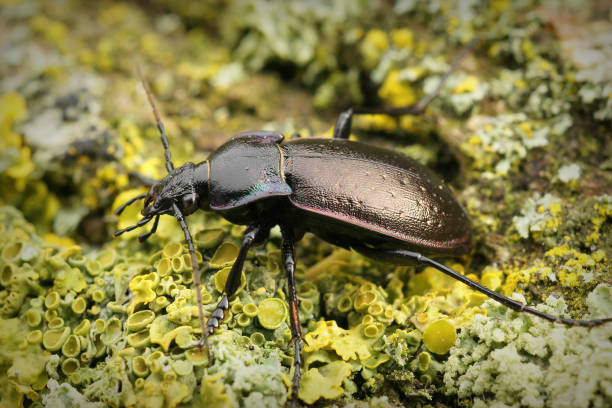Carabus nemoralis – The Bronze Ground Beetle
Table of Contents
Scientific Classification
| Kingdom | Animalia |
| Phylum | Arthropoda |
| Class | Insecta |
| Order | Coleoptera |
| Family | Carabidae |
| Genus | Carabus |
| Species | C. nemoralis |
| Scientific Name | Carabus nemoralis |
Description
Carabus nemoralis, commonly known as the bronze ground beetle, is quite the eye-catching insect. With its metallic sheen and robust form, it’s hard not to notice. These beetles usually range from 18 to 25 mm in length, and their elytra, or hardened forewings, feature distinct ridges. They sparkle in shades of bronze, copper, and even purplish tones, which shift depending on the angle of the light.
The body is elongated and slightly flattened, a design that allows for swift movement through leaf litter and soil. Their powerful mandibles are not just for show; they’re built for hunting and can easily cut through their prey. Unlike many of their beetle cousins, C. nemoralis can’t fly since its wings are fused beneath the elytra. Instead, it relies on its speed and stealth to navigate its environment.
That sleek, sharp appearance isn’t just for aesthetics — it’s a testament to millions of years of evolution.
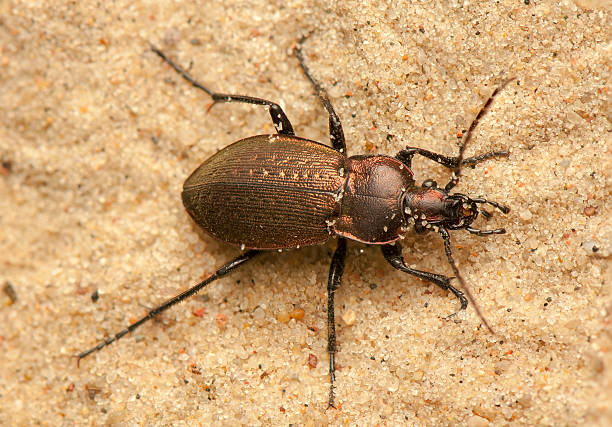
Distribution
Carabus nemoralis is a beetle native to northern and central Europe. It made its way to North America by accident in the 19th century and has since thrived, particularly in Canada and the northeastern United States.
This versatile beetle has found a home in various environments, from English hedgerows to Canadian gardens. You can spot it in places like the UK, Ireland, Germany, France, and Scandinavia. In North America, it tends to cluster in areas where people live closely together, especially in British Columbia, Ontario, Quebec, and parts of New England.
Habitat
The bronze ground beetle really loves cool, moist spots. In nature, you’ll find it thriving in deciduous and mixed forests, where it likes to tuck itself away under logs, stones, and those cozy layers of fallen leaves. Urban and suburban gardens are also perfect for them. You might spot them hiding under flowerpots, in compost heaps, or meandering along stone paths.
Carabus nemoralis is quite unique because it can flourish in both natural and disturbed areas. Whether it’s the damp soil of a shaded woodland or the edge of a vegetable garden, as long as there’s some cover and a good supply of prey, it feels right at home.
Having these beetles in your garden is actually a great advantage for gardeners since they munch on a variety of pest species.
Diet
This beetle is quite the fierce night hunter, playing a crucial role in keeping pests in check the natural way. Its diet mainly includes:
– Slugs (especially the younger ones)
– Caterpillars
– Earthworms
– Snails
– Insect larvae
– Ants and small spiders
Carabus nemoralis is a real gem for gardens and farms. It has a particular fondness for slugs, which can wreak havoc on crops and ornamental plants. With its sharp mandibles and sensitive antennae, this beetle is well-equipped to locate and tackle prey that’s often much larger than itself.
Every now and then, it might scavenge on decaying organic matter or plant material, but that’s more of a rare treat than a regular part of its diet.
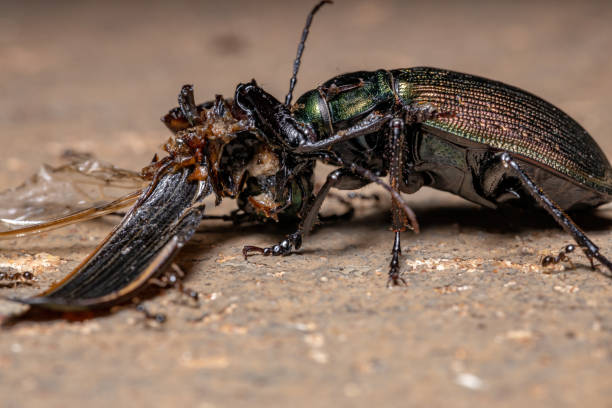
Behavior
During the day, Carabus nemoralis likes to keep a low profile, hiding away in dark, damp spots like under logs, stones, or a cozy layer of mulch. But as night falls, it comes alive, setting out on a mission to hunt for food. You’ll notice its movements are quick and purposeful, often retracing the same paths night after night.
Even though it looks a bit intimidating, this beetle isn’t aggressive towards humans and prefers to steer clear of any contact. It doesn’t have a stinger and will only bite if it feels threatened or is handled too roughly.
While it can’t take to the skies, it makes up for it with impressive agility and a surprisingly long stride. For defense, it relies on some pretty nasty-smelling chemicals from its abdomen, which help to ward off any would-be predators.
Lifespan
The average lifespan of Carabus nemoralis is about 2 to 4 years, which is quite impressive for an insect. After a lengthy larval stage that can last several months, they transition into adulthood.
These beetles are known to overwinter, meaning they find ways to survive the chilly months by burrowing into the soil or hiding beneath debris. As spring rolls around and temperatures start to rise, they come out of hiding, ready to feed and mate.
- Reproduction typically kicks off in early spring, right after the adults shake off their winter slumber. Mating follows a brief courtship, where the male might chase or gently nudge the female with his antennae.
- Once mating is complete, the female lays tiny clusters of eggs in damp soil or among leaf litter. These eggs are soft, white, and almost invisible to the naked eye.
- Life Stages:
- Egg – Incubates for about 1 to 2 weeks.
- Larva – Looks like a tiny, armored centipede. It’s aggressive and predatory, molting several times over a span of 2 to 4 months.
- Pupa – Forms a cocoon in the soil, transforming into an adult over the course of a few weeks.
- Adult – Emerges in the summer or autumn and may hibernate until the next spring.
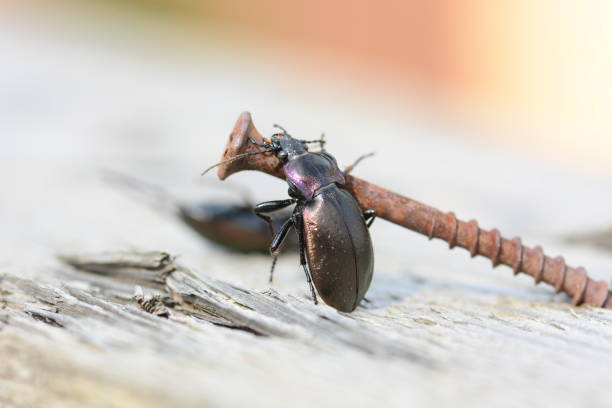
Predators
Despite its armor and chemical defenses, Carabus nemoralis is not invincible. Its primary predators include:
- Birds, particularly thrushes and robins
- Shrews and other small mammals
- Toads and amphibians
- Larger beetles or predatory insects
- Domestic pets, like cats digging in gardens
The beetle is active at night. Its speed and strong smells help it survive in many situations.
Nest
Unlike social insects, Carabus nemoralis doesn’t create a nest. Instead, when we talk about a “nest” in this context, we’re referring to the simple spot the female chooses to lay her eggs.
These spots are usually hidden away, in damp areas of soil that are rich in organic matter. Moisture and protection are crucial, as they give the larvae the best shot at survival.
After the eggs are laid, the female beetle steps back and doesn’t get involved in her offspring’s development.
Adaptations
Carabus nemoralis is truly a wonder of evolution. Let’s take a look at some of its most impressive adaptations:
Flightlessness: Instead of being a drawback, its fused wing covers actually provide greater durability and protection.
Hardened Elytra: This tough outer shell shields the beetle from predators and various environmental threats.
Powerful Mandibles: These strong jaws can easily pierce through soft-bodied prey like slugs.
Chemical Defense: When threatened, it releases a nasty odor to deter attackers.
Nocturnality: Being active at night helps it avoid predators and hunt for unseen prey.
Moisture Retention: Its hard shell minimizes water loss, allowing it to survive during dry spells.
Carabus nemoralis combines strength, agility, and stealth, making it well-suited to thrive in a variety of environments.
Mating Season
Mating usually starts in spring and early summer. This happens after the beetles wake up from their winter sleep. Males locate females via pheromone cues and antenna-based exploration.
Mating may last for several minutes to an hour. Then, the female continues her search for good nesting sites. Meanwhile, the male might mate with other females.
Breeding
The breeding process is relatively simple and instinct-driven. Females lay up to a hundred eggs over a period of several weeks. She places them in small soil crevices, among decaying plant matter, or under rocks.
After hatching, the larvae begin feeding almost immediately. Their form is long, armored, and segmented, with small legs and fierce mandibles. They hunt actively, just like the adults. They eat soft-bodied invertebrates to support their fast growth.
Pupation happens in late summer or fall. Some individuals become adults before winter. Others stay dormant until spring.
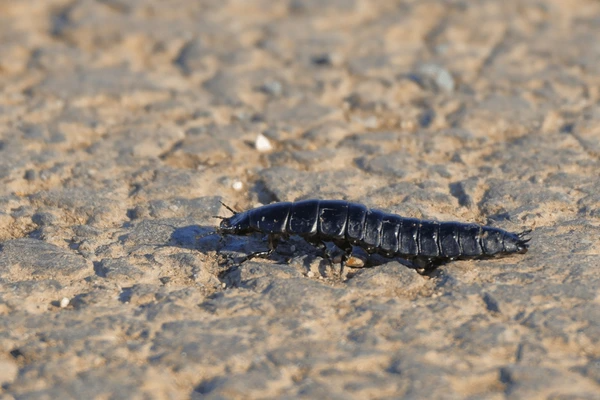
Interesting Facts
- Carabus nemoralis is often confused with other beetles in gardens. Its shiny, metallic appearance can be misleading.
- This beetle often eats slugs, so farmers and organic gardeners love it.
- These beetles show “territorial patrolling.” They go back to the same foraging paths night after night.
- They may look tough, but they are harmless to people. If they feel threatened, they just release a bad smell.
- Their larvae are just as fierce as the adults, proving that the apple doesn’t fall far from the tree in the beetle world.

Conservation Status
Carabus nemoralis is classified as a species of Least Concern in both Europe and North America. It’s quite common, adaptable, and shows a good level of resilience against human activities.
That said, there are some localized threats to be aware of:
The use of pesticides in farming can significantly decrease their populations.
Urban development and habitat fragmentation can lead to isolated groups.
Soil pollution and degradation can negatively impact developing larvae.
Encouraging organic gardening practices can help maintain ground cover and minimize pesticide use, allowing plants to flourish in both urban and rural settings.
It’s crucial for maintaining the balance in ecosystems and gardens. With its shiny exterior and stealthy movements, this little creature plays a vital role in nature’s pest control efforts.


